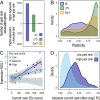Social history and exposure to pathogen signals modulate social status effects on gene regulation in rhesus macaques
- PMID: 31611381
- PMCID: PMC7519294
- DOI: 10.1073/pnas.1820846116
Social history and exposure to pathogen signals modulate social status effects on gene regulation in rhesus macaques
Abstract
Social experience is an important predictor of disease susceptibility and survival in humans and other social mammals. Chronic social stress is thought to generate a proinflammatory state characterized by elevated antibacterial defenses and reduced investment in antiviral defense. Here we manipulated long-term social status in female rhesus macaques to show that social subordination alters the gene expression response to ex vivo bacterial and viral challenge. As predicted by current models, bacterial lipopolysaccharide polarizes the immune response such that low status corresponds to higher expression of genes in NF-κB-dependent proinflammatory pathways and lower expression of genes involved in the antiviral response and type I IFN signaling. Counter to predictions, however, low status drives more exaggerated expression of both NF-κB- and IFN-associated genes after cells are exposed to the viral mimic Gardiquimod. Status-driven gene expression patterns are linked not only to social status at the time of sampling, but also to social history (i.e., past social status), especially in unstimulated cells. However, for a subset of genes, we observed interaction effects in which females who fell in rank were more strongly affected by current social status than those who climbed the social hierarchy. Taken together, our results indicate that the effects of social status on immune cell gene expression depend on pathogen exposure, pathogen type, and social history-in support of social experience-mediated biological embedding in adulthood, even in the conventionally memory-less innate immune system.
Keywords: biological embedding; dominance rank; gene expression; immune response; social adversity.
Conflict of interest statement
The authors declare no competing interest.
Figures




Similar articles
-
Dominance rank-associated gene expression is widespread, sex-specific, and a precursor to high social status in wild male baboons.Proc Natl Acad Sci U S A. 2018 Dec 26;115(52):E12163-E12171. doi: 10.1073/pnas.1811967115. Epub 2018 Dec 11. Proc Natl Acad Sci U S A. 2018. PMID: 30538194 Free PMC article.
-
Social status alters chromatin accessibility and the gene regulatory response to glucocorticoid stimulation in rhesus macaques.Proc Natl Acad Sci U S A. 2019 Jan 22;116(4):1219-1228. doi: 10.1073/pnas.1811758115. Epub 2018 Dec 11. Proc Natl Acad Sci U S A. 2019. PMID: 30538209 Free PMC article.
-
The ORF61 Protein Encoded by Simian Varicella Virus and Varicella-Zoster Virus Inhibits NF-κB Signaling by Interfering with IκBα Degradation.J Virol. 2015 Sep;89(17):8687-700. doi: 10.1128/JVI.01149-15. Epub 2015 Jun 17. J Virol. 2015. PMID: 26085158 Free PMC article.
-
Manipulation of Non-canonical NF-κB Signaling by Non-oncogenic Viruses.Arch Immunol Ther Exp (Warsz). 2019 Feb;67(1):41-48. doi: 10.1007/s00005-018-0522-x. Epub 2018 Sep 8. Arch Immunol Ther Exp (Warsz). 2019. PMID: 30196473 Free PMC article. Review.
-
Immune mechanisms in infections of poultry.Vet Immunol Immunopathol. 1987 May;15(1-2):87-113. doi: 10.1016/0165-2427(87)90107-3. Vet Immunol Immunopathol. 1987. PMID: 3303653 Review.
Cited by
-
Holistic Rehabilitation: Biological Embedding of Social Adversity and Its Health Implications.Phys Ther. 2022 Jan 1;102(1):pzab245. doi: 10.1093/ptj/pzab245. Phys Ther. 2022. PMID: 34718801 Free PMC article.
-
Biological embedding of experience: A primer on epigenetics.Proc Natl Acad Sci U S A. 2020 Sep 22;117(38):23261-23269. doi: 10.1073/pnas.1820838116. Epub 2019 Oct 17. Proc Natl Acad Sci U S A. 2020. PMID: 31624126 Free PMC article. Review.
-
The dynamics of dominance: open questions, challenges and solutions.Philos Trans R Soc Lond B Biol Sci. 2022 Feb 28;377(1845):20200445. doi: 10.1098/rstb.2020.0445. Epub 2022 Jan 10. Philos Trans R Soc Lond B Biol Sci. 2022. PMID: 35000440 Free PMC article.
-
Broadening primate genomics: new insights into the ecology and evolution of primate gene regulation.Curr Opin Genet Dev. 2020 Jun;62:16-22. doi: 10.1016/j.gde.2020.05.009. Epub 2020 Jun 20. Curr Opin Genet Dev. 2020. PMID: 32569794 Free PMC article. Review.
-
Sickness and the Social Brain: Love in the Time of COVID.Front Psychiatry. 2021 Feb 22;12:633664. doi: 10.3389/fpsyt.2021.633664. eCollection 2021. Front Psychiatry. 2021. PMID: 33692712 Free PMC article.
References
-
- Felitti V. J., et al. , Relationship of childhood abuse and household dysfunction to many of the leading causes of death in adults. The Adverse Childhood Experiences (ACE) study. Am. J. Prev. Med. 14, 245–258 (1998). - PubMed
-
- Sapolsky R. M., The influence of social hierarchy on primate health. Science 308, 648–652 (2005). - PubMed
-
- Silk J. B., Social components of fitness in primate groups. Science 317, 1347–1351 (2007). - PubMed
Publication types
MeSH terms
Substances
Grants and funding
LinkOut - more resources
Full Text Sources
Medical
Molecular Biology Databases
Research Materials
Miscellaneous

